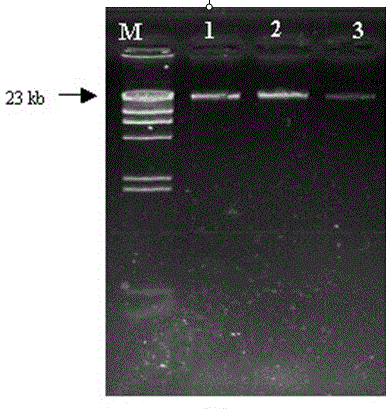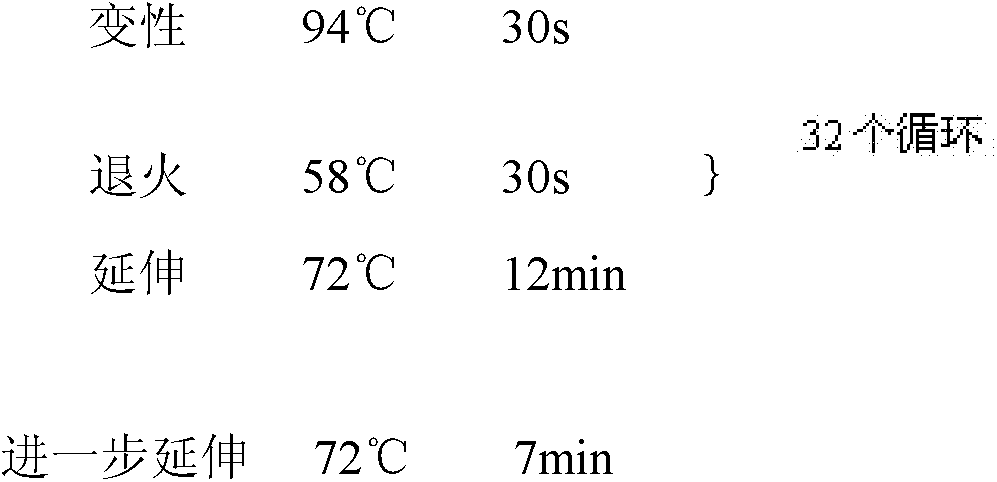Application of Ectoine used as synergist in PCR
A technology of tetrahydropyrimidine and a synergist is applied in the field of tetrahydropyrimidine enhancing PCR amplification efficiency, which can solve problems such as increasing non-specific amplification, and achieve the effects of improving operation, improving PCR specificity and low cost
- Summary
- Abstract
- Description
- Claims
- Application Information
AI Technical Summary
Problems solved by technology
Method used
Image
Examples
preparation example Construction
[0013] 1. Preparation of ectoine additive: Weigh 15 mg of commercially available ectoine, place it in a sterilized 1.5ml centrifuge tube, add sterilized water to dissolve it, and finally set the volume to 1ml. 20min sterilization.
[0014] 2. The configuration of the PCR reaction system: the DNA fragments to be amplified are different, and the dNTP, Mg 2+ 1. The amount of template added is different; an appropriate amount of ectoine solution is added to the above reaction system, and the amount of double distilled water added should be deducted accordingly according to the addition of ectoine solution.
[0015] 3. PCR reaction operation: pre-denaturation, denaturation, annealing temperature and time should be selected according to the template, and the extension time should be selected according to the length of the target fragment to be amplified.
[0016] 4. Detection of PCR amplification products: detection by agarose gel electrophoresis.
Embodiment 1
[0017] Example 1: Optimal amplification of ectoine to a 23kb DNA fragment
[0018] 1. Prepare 15mg / ml ectoine aqueous solution.
[0019] 2. Configuration of PCR reaction system:
[0020] 10×PCR Buffer 2.5ul
[0021] dNTP (2.5mM) 5ul
[0022] Primer 1 (2.0uM) 1ul
[0023] Primer 2 (2.0uM) 1ul
[0024] Mg 2+ (25mM) 1.5ul
[0025] After configuring the above reaction system, add an appropriate amount of ectoine additive. 1 in the attached figure means adding 10ul ectoine solution, and add sterilized double distilled water to make up the 25ul system. 2 in the figure means adding 14ul ectoine solution. , the final concentrations of the ectoine solution in the PCR reaction system were 6 mg / ml and 8.4 mg / ml respectively. In the control group, the ectoine solution was replaced with 14ul sterilized double distilled water.
[0026] 3. PCR reaction run:
[0027]
[0028]
[0029] 4. After PCR reaction, use agarose gel electrophoresis to detect: the results are shown in...
PUM
| Property | Measurement | Unit |
|---|---|---|
| concentration | aaaaa | aaaaa |
Abstract
Description
Claims
Application Information
 Login to View More
Login to View More - R&D
- Intellectual Property
- Life Sciences
- Materials
- Tech Scout
- Unparalleled Data Quality
- Higher Quality Content
- 60% Fewer Hallucinations
Browse by: Latest US Patents, China's latest patents, Technical Efficacy Thesaurus, Application Domain, Technology Topic, Popular Technical Reports.
© 2025 PatSnap. All rights reserved.Legal|Privacy policy|Modern Slavery Act Transparency Statement|Sitemap|About US| Contact US: help@patsnap.com



